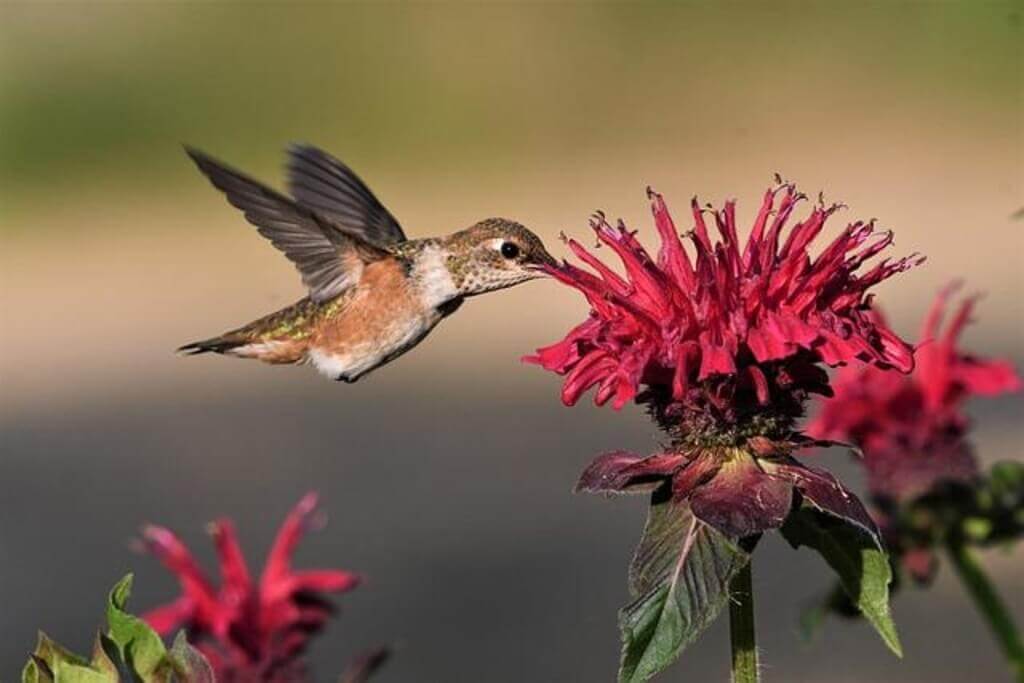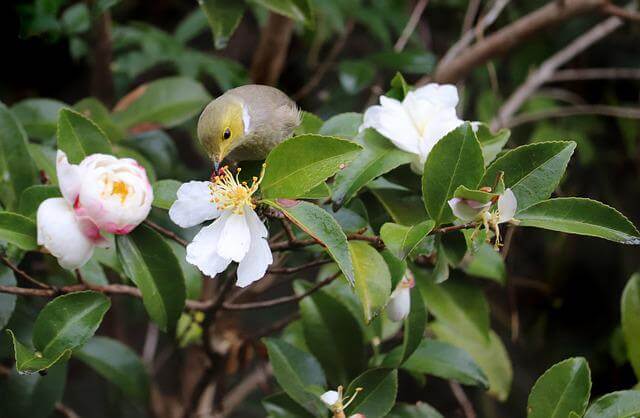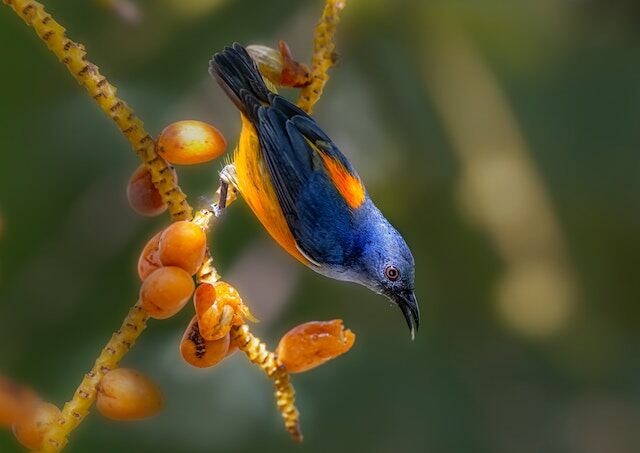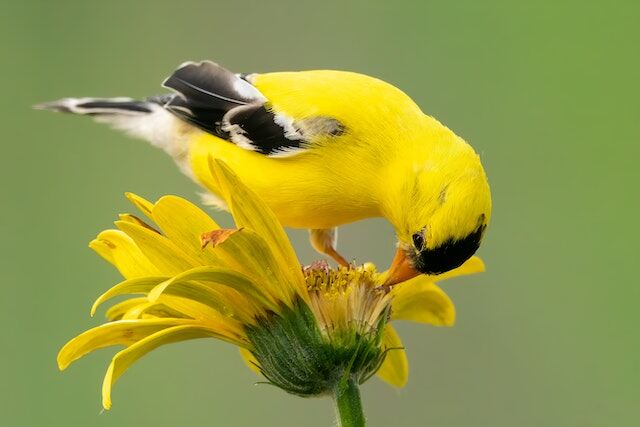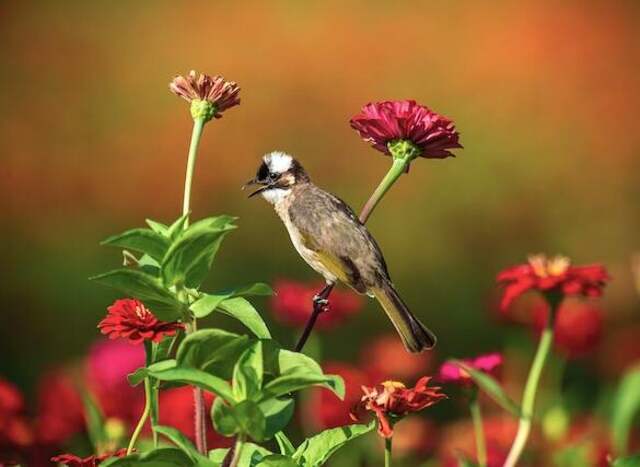I’ve always been intrigued by the fascinating relationship between animals and plants. When we think of pollinators, we often picture bees, butterflies, and other insects. However, did you know that birds also play a crucial role in pollination?
In this article, we will explore the importance of bird pollinators and their role in sustaining our environment. We will dive into the surprising discovery of bird pollinators and the specific adaptations that enable them to interact with flowers in a unique way. We’ll also examine the significance of bird-mediated pollination for plant reproduction and genetic diversity.
Table of Contents
- 1 Key Takeaways
- 2 Do Birds Pollinate?
- 3 Understanding Pollination
- 4 Bird Pollinators: An Unexpected Discovery
- 5 The Unique Relationship Between Birds and Flowers
- 6 The Importance of Bird Pollination
- 7 Examples of Bird Pollinators
- 8 Pollination Strategies of Birds
- 9 The Mutualistic Relationship: Birds and Plants
- 10 Conservation of Bird Pollinators
- 11 Conclusion
- 12 FAQs
- 12.1 Do birds play a role in pollination?
- 12.2 What is pollination?
- 12.3 Are there specific bird species that are known to be pollinators?
- 12.4 How do birds interact with flowers for pollination?
- 12.5 What is the importance of bird pollination?
- 12.6 Can you provide examples of bird pollinators?
- 12.7 What are the pollination strategies of birds?
- 12.8 How do birds benefit from their relationship with plants?
- 12.9 Why is it important to conserve bird pollinators?
- 13 Author
Key Takeaways
- Birds are important pollinators, alongside bees, butterflies, and other insects.
- Bird pollinators have been discovered in different parts of the world, highlighting the diversity of avian species that participate in pollination.
- Birds have unique characteristics that allow them to interact with flowers in a special way, contributing to the efficiency of pollination.
- Bird-mediated pollination is essential to ecosystem health and maintaining biodiversity.
- Conservation efforts are crucial for protecting bird pollinators and their habitats.
Do Birds Pollinate?
Birds serve as vital pollinators for wildflowers worldwide. In the continental United States, hummingbirds play a central role in wildflower pollination. Meanwhile, in unique ecosystems like Hawaii and Australia, honeycreepers and honeyeaters emerge as essential contributors to this intricate process, showcasing the diverse and crucial role of birds in global pollination.
Understanding Pollination
Before diving into the role of birds in pollination, it’s essential to understand what pollination is and how it occurs. Pollination is the process by which pollen transfers from the male part of a flower to the female part, allowing for the fertilization and reproduction of the plant.
Avian pollination, also known as bird-mediated pollination, is a unique form of pollination that occurs when birds visit and interact with flowers. Birds typically play a significant role in pollinating flowers with bright colors, strong fragrances, and tubular shapes that are well-suited for their long beaks and tongues.
Bird-mediated pollination can occur in several different ways, depending on the type of bird and the kind of flower. Some birds, such as hummingbirds, are able to hover in front of flowers and extend their long beaks deep into the petals to obtain nectar. As they do this, pollen from the stamen is transferred to their feathers and then deposited on the stigma of other flowers they visit.
Other birds, such as sunbirds, have curved bills that allow them to reach into flowers from the side, brushing against the anthers and picking up pollen that they carry to other flowers. Birds can also play a role in pollination by eating fruit and dispersing seeds, which aids in the reproduction of plants.
Bird Pollinators: An Unexpected Discovery
When thinking about pollinators, birds may not be the first creatures that come to mind. However, scientists have discovered that many bird species play a pivotal role in the process of pollination. These bird pollinators can be found all over the world, and they are essential to maintaining the delicate balance of our ecosystems.
There are over 2,000 species of birds that have been identified as bird pollinators. These species range from hummingbirds to sunbirds to honeyeaters. Each bird species has its unique characteristics that make them ideal for pollination. For example, hummingbirds have long, thin beaks that can reach deep into flowers to obtain nectar, while sunbirds have curved beaks that can easily access hard-to-reach nectar sources.
Bird Pollinator Species
Some examples of bird pollinator species include:
| Bird Species | Region | Flower Pollinated |
|---|---|---|
| Hummingbirds | Americas | Tubular flowers |
| Sunbirds | Africa, Asia, and Australia | Tubular and non-tubular flowers |
| Honeyeaters | Australia, New Zealand, and Pacific Islands | Tube-shaped flowers |
These bird pollinators are crucial to the survival of many plant species. Without these birds, certain plants would not be able to reproduce, leading to a decline in biodiversity.
Role of Birds in Pollination
Birds play a vital role in pollination. They transfer pollen between flowers as they feed on nectar, ensuring that the plants can reproduce. Unlike bees, which collect pollen on their bodies as they move from one flower to another, birds do not intentionally collect pollen. Instead, pollen sticks to their feathers as they feed on nectar, and they transfer it from flower to flower as they move.
Birds also have a unique advantage over other pollinators. They can fly further distances and access flowers in higher locations, enabling them to pollinate a broader range of plant species.
In conclusion, bird pollinators are an integral part of our environment and play a critical role in plant reproduction. It’s essential to recognize and protect these important pollinators to maintain the health and diversity of our ecosystems.
The Unique Relationship Between Birds and Flowers
When it comes to flower pollination, birds are unique in their approach. Unlike other animals that inadvertently collect pollen as they move around, birds have specific adaptations that enable them to efficiently pollinate flowers.
One of the most notable characteristics of bird pollinators is their long, slender beaks. These beaks are designed to fit perfectly into the narrow, tubular shape of certain flowers, allowing birds to reach the nectar at the base of the petals. As birds drink the nectar, their heads brush against the flower’s reproductive structures, transferring pollen from one flower to another.
Another key feature of bird pollinators is their keen sense of color. Many bird-pollinated flowers have bright, showy petals that are highly visible to birds. These flowers often have a unique color pattern that serves as a visual cue to attract birds. For example, some bird-pollinated flowers have red or orange nectar guides that lead birds directly to the flower’s reproductive structures.
“Birds have evolved unique characteristics that enable them to interact with flowers in a special way”
Birds’ ability to hover in mid-air is also advantageous in flower pollination. This hovering allows them to remain stationary in front of a flower, accessing the nectar without disturbing the delicate reproductive structures. Additionally, some bird species can hang upside-down from flowers to access the nectar, further increasing their efficiency as pollinators.
The unique relationship between birds and flowers goes beyond just pollination. Some bird species have co-evolved with specific plant species, meaning that they rely on each other for survival. For example, the long-billed hermit hummingbird is the primary pollinator of the heliconia plant. The heliconia plant, in turn, provides a critical food source for the hummingbird.
Overall, the intricate relationship between birds and flowers highlights the beauty and complexity of the natural world. Understanding the unique characteristics of bird pollinators can help us appreciate the importance of their role in maintaining the health and diversity of ecosystems.
The Importance of Bird Pollination
Bird pollination is essential for maintaining the health and diversity of our ecosystems. As mentioned earlier, bird pollinators contribute significantly to the reproduction and genetic diversity of plant species by transferring pollen from one flower to another.
In fact, some studies estimate that bird pollinators are responsible for pollinating up to 20% of the world’s flowering plant species. This figure underscores the critical role played by these avian species in sustaining our environment.
“Birds are the most important pollinators of tropical ecosystems, and their contribution is irreplaceable,” says Dr. Robert J. Marquis, a professor of biology at the University of Missouri-St. Louis.
Without bird pollination, many plant species would struggle to reproduce, leading to a decline in biodiversity and ecosystem health. As a result, understanding and valuing the importance of bird pollinators is crucial for preserving our natural world.
Moreover, bird pollination can also benefit humans by supporting the growth of crops and other plants that are essential for food, medicine, and other resources.
Bird Pollination Facts
Here are some fascinating facts about bird pollination:
- Birds are attracted to brightly colored and scented flowers, which make it easier for them to find nectar and pollen.
- Birds can see colors that humans cannot, including ultraviolet light, allowing them to distinguish between flowers with different levels of nectar and pollen.
- Hummingbirds are among the most well-known bird pollinators, as they are adapted to hover near flowers while feeding and can move quickly from one bloom to the next.
- Other bird species, such as sunbirds, lorikeets, and honeyeaters, also play critical roles in pollinating various plant species.
By recognizing and celebrating the importance of bird pollination, we can take steps to protect and conserve these remarkable creatures for generations to come.
Examples of Bird Pollinators
Throughout the world, numerous bird species serve as important pollinators for a wide range of plants. Here are just a few examples:
| Bird Species | Region | Plants Pollinated |
|---|---|---|
| Hummingbirds | Americas | Fuchsia, Lobelia, Penstemon |
| Sunbirds | Africa, Asia, Australia | Aloe, Bird of Paradise, Protea |
| Honeyeaters | Australia, New Zealand | Banksia, Grevillea, Hakea |
| Honeycreepers | Hawaii, South Pacific | Ohia, Lehua, I’iwi |
| Flowerpiercers | Central and South America | Passiflora, Heliconia, Cavendishia |
| Vanga birds | Madagascar | Ravenala, Traveller’s palm, Impatiens |
These examples highlight the diversity of bird pollinators and the important role they play in pollinating a variety of plant species across different regions of the world. It’s important to note that these are just a few examples, and there are countless other bird species that contribute to pollination.
The significance of bird pollinators cannot be overstated. Without their crucial role in spreading pollen, many plant species would struggle to reproduce, resulting in a loss of biodiversity and potential ecosystem collapse. By valuing and protecting bird pollinators, we can ensure the continued health and sustainability of our natural world.
Pollination Strategies of Birds
Birds have unique pollination strategies that set them apart from other pollinators. Unlike bees, which collect pollen on their bodies as they move from flower to flower, birds do not have specialized body parts for carrying pollen. Instead, they rely on a combination of visual cues and physical adaptations to successfully pollinate flowering plants.
Visual Cues
Many bird-pollinated flowers are brightly colored and have a tubular shape that is well-suited for birds with long, narrow beaks. The flowers may also have landing platforms or other structures that provide a stable surface for birds to perch on while feeding on nectar. In addition, some flowers have distinctive patterns or scents that help birds locate them from a distance.
Physical Adaptations
Birds have several physical adaptations that enable them to pollinate flowers effectively. For example, their bills are often curved or serrated, allowing them to access nectar deep within the flower. Some birds, such as honeycreepers, have specialized tongues that can reach into the narrowest parts of the flower to extract nectar. Additionally, some birds have stiff tail feathers that they use to support their body weight while hovering in front of flowers.
Bird-Mediated Pollination
Avian pollination, also known as bird-mediated pollination, is a widespread phenomenon in the natural world. Some estimates suggest that as many as 10% of flowering plant species rely on birds for pollination. While bees and other insects are also important pollinators, bird pollination is particularly significant in certain ecosystems, such as tropical rainforests.
Several bird species have been identified as important pollinators, including hummingbirds, sunbirds, and honeyeaters. These birds are found in a range of habitats, from forests and scrublands to deserts and alpine meadows. Some bird-pollinated flowers are also highly specialized, relying on a single bird species for pollination.
Overall, bird pollination plays a critical role in many ecosystems, helping to maintain genetic diversity and fostering the growth of new plant species. By understanding the pollination strategies of birds and the importance of their role as pollinators, we can work to protect and conserve these remarkable creatures for generations to come.
The Mutualistic Relationship: Birds and Plants
As we’ve seen, birds play a crucial role in flower pollination. However, their contribution goes beyond the mere transfer of pollen. In fact, the relationship between birds and flowers is a mutualistic one, where both organisms benefit from the interaction.
Birds are attracted to flowers for their nectar, a sugary liquid that serves as a source of energy for the bird. As the bird feeds on the nectar, it inadvertently picks up pollen on its feathers and beak, which is then deposited onto the next flower it visits, facilitating pollination.
The flowers, in turn, benefit from the birds’ visits. By consuming nectar, the birds act as pollinators, increasing the chances of successful fertilization and seed production. Furthermore, as birds are attracted to brightly colored flowers, this can increase the likelihood of pollination occurring, particularly in low-light conditions.
The mutualistic relationship between birds and flowers has played a significant role in the evolution of both organisms over millions of years. Through coevolution, birds have developed specialized beaks and tongues that help them extract nectar from flowers in different ways, while flowers have evolved specific shapes, colors, and scents to attract their avian pollinators.
The importance of this relationship extends beyond the individual organisms and has implications for entire ecosystems. As we’ve seen, bird pollination contributes to plant reproduction and genetic diversity. This, in turn, is crucial for maintaining biodiversity and ecosystem health, as it ensures the survival of plant species and the animals that rely on them for food and habitat.
Therefore, it is vital that we recognize and value the importance of bird pollination and take steps to conserve and protect bird pollinators and their habitats. Through informed management and conservation efforts, we can ensure the continued presence of these remarkable creatures and the vital role they play in sustaining our environment.
Conservation of Bird Pollinators
The vital role played by bird pollinators cannot be overstated. These remarkable creatures contribute significantly to the health and sustainability of our environment, ensuring genetic diversity and plant reproduction. However, bird pollinators face numerous threats that jeopardize their very existence, including habitat loss, pesticides, and climate change. As such, it is crucial to implement conservation efforts aimed at protecting these essential creatures.
To conserve bird pollinators, we must first recognize their critical role in the ecosystem. This acknowledgment can be achieved through public awareness campaigns, education, and outreach programs. By educating the public about the importance of bird pollinators, we can foster a greater appreciation for these creatures and build momentum for conservation efforts.
In addition to public awareness campaigns, we must also implement policies and programs designed to protect bird pollinators’ habitats. This includes preserving natural areas, creating bird-friendly gardens and green spaces, and reducing or eliminating the use of harmful pesticides. It also entails promoting sustainable farming practices that support bird pollinators and their habitats.
Finally, we must invest in research that advances our understanding of bird pollinators and their conservation needs. This includes studying bird pollinator populations, their migration patterns, and behavior, as well as identifying and addressing threats to their survival. This knowledge can be used to inform conservation efforts and policies, ensuring that we take the most effective action to preserve these essential creatures.
Challenges and Outlook
The conservation of bird pollinators is a complex and challenging task that requires collaboration and commitment from a range of stakeholders. With continued efforts and investment, we can protect these remarkable creatures and ensure their presence for generations to come. By doing so, we also safeguard the health and sustainability of our environment, supporting the natural systems that sustain all life.
Conclusion
In conclusion, I have explored the fascinating question of whether birds are involved in the process of pollination. Through my research, I have discovered the importance of bird pollinators and the role they play in sustaining our environment.
It is clear that birds play a significant role in pollination, with various bird species actively participating in the process. Their unique characteristics and behaviors make them vital pollinators, contributing to the beauty and sustainability of our environment.
The mutualistic relationship between birds and plants goes beyond mere pollination, with both parties deriving benefits from their interaction. By recognizing and valuing the importance of bird pollination, we can take steps to protect and conserve these remarkable creatures for generations to come.
Conservation efforts aimed at preserving bird pollinators are critical, given their critical role in maintaining biodiversity and ecosystem health. By protecting their habitats, we can ensure their continued presence and safeguard the delicate balance of our natural world.
In conclusion, I urge readers to recognize and appreciate the significance of bird pollination. By doing so, we can take effective measures to protect and conserve these extraordinary creatures and the fragile ecosystems that depend on them.
FAQs
Do birds play a role in pollination?
Yes, birds are involved in the process of pollination. They act as important pollinators for various plant species.
What is pollination?
Pollination is the transfer of pollen from the male reproductive organ of a flower to the female reproductive organ, leading to fertilization and the production of seeds.
Are there specific bird species that are known to be pollinators?
Yes, there are several bird species that actively participate in pollination, such as hummingbirds, sunbirds, honeyeaters, and certain species of bats.
How do birds interact with flowers for pollination?
Birds have evolved unique characteristics, such as long beaks and tongues, that allow them to reach into flowers to obtain nectar. In the process, they unwittingly pick up and transfer pollen from one flower to another.
What is the importance of bird pollination?
Bird pollination plays a crucial role in maintaining biodiversity and ecosystem health. It ensures the reproduction and genetic diversity of many plant species, ultimately contributing to the overall health of the environment.
Can you provide examples of bird pollinators?
Examples of bird pollinators include the Ruby-throated Hummingbird, the Malachite Sunbird, the New Holland Honeyeater, and the Lesser Long-nosed Bat.
What are the pollination strategies of birds?
Birds have various strategies for obtaining nectar and transporting pollen. Some species hover in front of flowers while feeding, while others perch and insert their beaks or tongues into flowers. In both cases, pollen is transferred between flowers.
How do birds benefit from their relationship with plants?
Birds benefit from the nectar provided by flowers as a source of energy. They also inadvertently assist in plant reproduction, ensuring the availability of future food sources.
Why is it important to conserve bird pollinators?
Conserving bird pollinators is crucial in maintaining healthy ecosystems and sustaining plant diversity. Protecting their habitats and food sources ensures their continued presence and the vital role they play in pollination.
Related Post:

